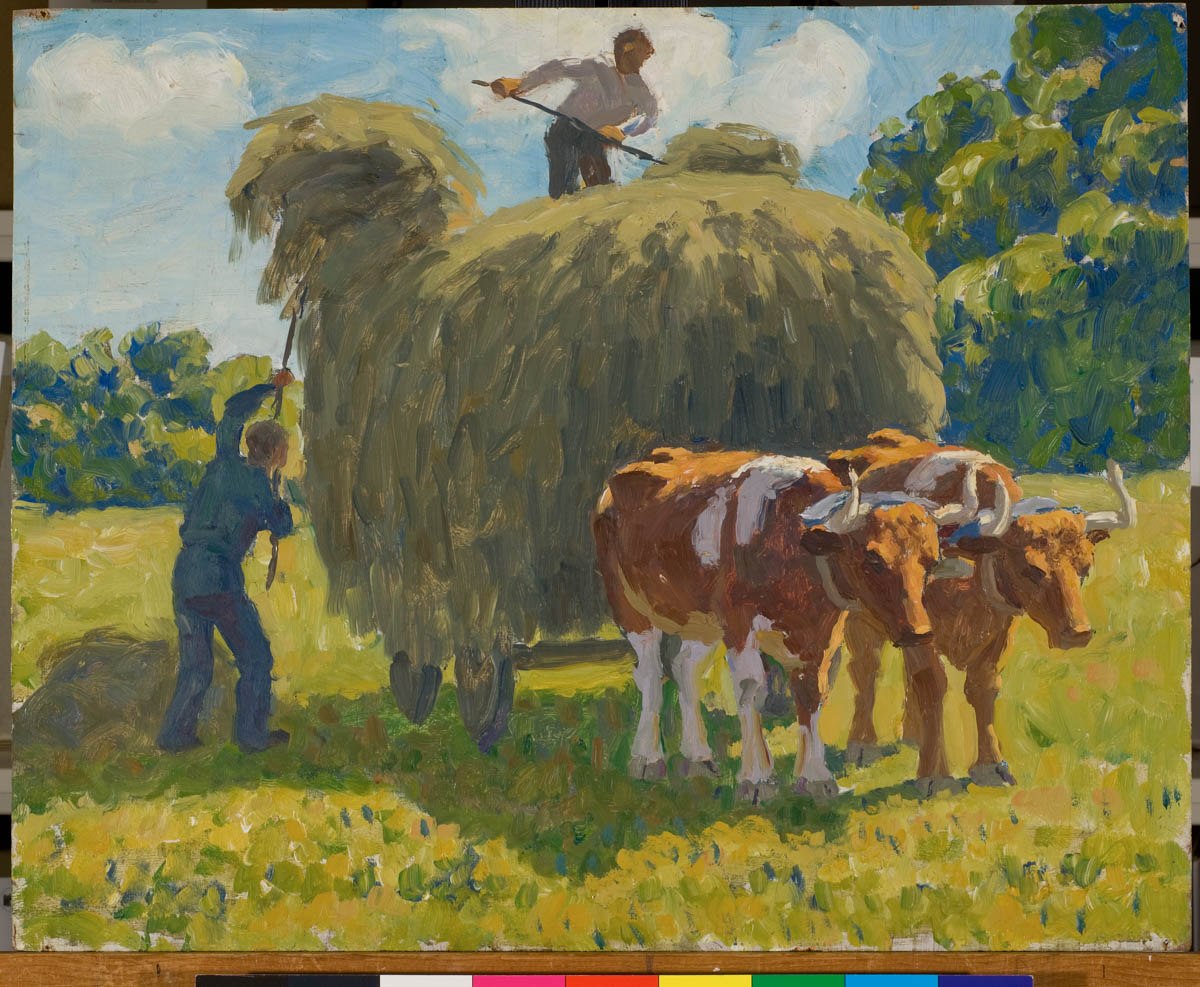Hauling and Harrowing
Technological Change
- The Museum and Café will be closed Friday, July 4.
Home | Biography | Volkert’s Work | Historic Footage | Timeline | Scrapbook
Edward Volkert was attracted to Lyme by the availability of his favorite subject, livestock, on the area’s farms. Living on Sterling City Road, he often depicted long, hilly vistas cleared of trees generations earlier by settler colonists. Those same colonists and their descendants had overtaken the once-wooded uplands that were the Nehantics’ hunting grounds, in part to claim space for larger farms to support their livestock.
The land’s Native American residents had cultivated beans, corn, and squash, plants whose growth supported one another, fertilizing them with shells and small fish. They did not use animals to farm. By contrast, settlers farmed as they had in their home countries, bringing livestock with them to New England. By 1900, there were 21.6 million work animals in the United States, many on farms.(1) In the early 20th century, the Lyme farmer in Volkert’s painting Harrowing uses oxen like his settler ancestors, pairing them with a factory-made disc harrow but not yet embracing steam or gas-powered machinery increasingly used elsewhere. He walks beside his team to maintain their efforts, the fresh earth marking their progress as they level the soil for planting.
Industrialization and mechanization had a decades-long foothold in New England by the era of the 19-teens and 1920s depicted in Volkert’s works.(2) Yet that history finds little visual acknowledgment on his canvases. The artist divided his time between his native Cincinnati, Ohio, and the Northeast, perhaps honing his observations about the less technological approach to farming in upland Connecticut, long outpaced by the Midwest in terms of agricultural productivity. According to his granddaughter, Volkert gravitated to Lyme in part because farming was still practiced there with traditional methods.(3) Steep hills made it one of dwindling number of regions where oxen, rather than machinery, were still used for plowing. The artist gravitated toward subjects like that in Ox with Haywagon, where labor is performed by hand. Cultivated, or English hay, like that in the cart, had replaced native salt hay in New England fields over the course of the 19th century. The cut stalks have been left in piles in the field, and are now being forked onto a wagon that will take them to the barn for winter storage in bales or stacks. Volkert’s plein-air painting radiates sunlight of the sort farmers hoped would persist until the hay was cut and gathered in—uncertain natural factors in their success rather than the regularity and reliability associated with machines. The artist’s emphasis on farm laborers resonated with viewers during the 1920s—when this picture was likely painted—who by then admired physical work that was being replaced by machines. By 1930, when Volkert was still painting his celebrations of animal-drawn carts and farm implements, the country was already home to 920,000 tractors, numbers resulting from a decade of innovation in gasoline tractors powered by competition between manufacturers such as Ford and International Harvester.(4) The adoption of technologies such as tractors paralleled the reduction in the number of Americans farming. While 41% of the workforce farmed in 1900, by 1930, just 21.5% of the population were farmers.(5)
Footnotes
- See Carolyn Dmitri, Anne Effland, and Neilson Conklin, “The 20th Century Transformation of U.S. Agriculture and Farm Policy.” United State Department of Agriculture, Economic Information Bulletin, no. 3 (June 2005), 6. https://www.ers.usda.gov/webdocs/publications/44197/13566_eib3_1_.pdf
- Iron plows were present in Connecticut by 1820, and accelerated in their adoption over the next decade. Implements such as the “Hawkes” Plow, made in Hartford, became commonplace by the 1830s. See William H. Brewster, “A Century of Connecticut Agriculture,” Address to the Farmer’s Convention of the Connecticut Board of Agriculture, December 18, 1894. Published in Twenty-Eighth Annual Report of the Secretary of the Connecticut Board of Agriculture, 1894 (Hartford, Conn.: Fowler and Miller, 1895), 48. https://books.google.com/books?id=_H01AQAAMAAJ&q=hawkes+&pg=PA48#v=snippet&q=hawkes&f=false
- Ruth L. Middleton, Ruth L. Middleton, “The Volkert Legacy,” typescript. Volkert Artist File, Florence Griswold Museum, p. 33.
- Carolyn Dmitri, Anne Effland, and Neilson Conklin, “The 20th Century Transformation of U.S. Agriculture and Farm Policy.” United State Department of Agriculture, Economic Information Bulletin, no. 3 (June 2005), 6. https://www.ers.usda.gov/webdocs/publications/44197/13566_eib3_1_.pdf. Ford began production of the Fordson tractor in 1917, in part responding to horse shortages during World War I. By 1920, the 100,000th tractor rolled off the assembly line. See FORDSON TRACTOR/ NO. 100,000 / Leaving Final Assembly Line / at DEARBORN FACTORY / 10:45 A.M. FEB.21, 1920. Collections of The Henry Ford, Gift of Ford Motor Company. URL: https://www.thehenryford.org/collections-and-research/digital-collections/artifact/33199/#slide=gs-198724 On the development and integration of gas-powered tractors in the 1920s, including the general purpose Farmall from International Harvester, see William J. White, “Economic History of Tractors in the United States,” EH.Net Encyclopedia, edited by Robert Whaples. March 26, 2008. URL: http://eh.net/encyclopedia/economic-history-of-tractors-in-the-united-states/
- See Carolyn Dmitri, Anne Effland, and Neilson Conklin, “The 20th Century Transformation of U.S. Agriculture and Farm Policy.” United State Department of Agriculture, Economic Information Bulletin, no. 3 (June 2005), 2. https://www.ers.usda.gov/webdocs/publications/44197/13566_eib3_1_.pdf
Farm Labor | Health & the Food Supply | Rural & Urban Relationships | Technological Change
Home | Biography | Volkert’s Work | Historic Footage | Timeline | Scrapbook

![Untitled [Cows]](https://florencegriswoldmuseum.org/wp-content/uploads/2020/12/2001_37_2-1.jpg)

